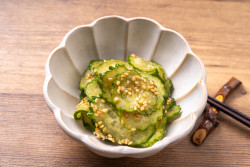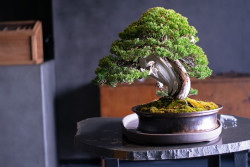
July 30, 2009
Spirit Parties
Japan's Obon and summer festivals are loud and mad enough to wake the dead - Here are a few of the major events being held around the country during the coming month.
By Metropolis
Obon Fever
From ghost hunting to dancing in the streets, Japan’s festival of the dead has got it all
What is Obon?
The name comes from urabon, the Feast of Lanterns. This Buddhist festival is traditionally honored as a way of rescuing your ancestors from the Realm of Hungry Ghosts, a plane of the afterlife where people are perpetually hung upside down (well, it beats fire and brimstone, at least). Obon also has roots in the ancestor worship of the Shinto religion. Today, it’s morphed into a folk festival where residents gather to dance, drink and commune with the spirits of their ancestors, who travel down to the mortal plane for the duration of the celebrations.
When is Obon?
Back in the Edo period, Bon dances were traditionally held on the 15th day of the seventh month. Since Japan followed the lunar calendar at that time, this typically fell around the end of August. When Emperor Meiji switched everything to the Western calendar in 1873, areas throughout the country were faced with the problem of when to celebrate. Some communities—especially in the Kanto region—kept the festivities on the same day, which under the new system became July 15. Others decided to bump the celebrations back a month (known as tsuki-okure) and hold Obon on August 15, which was closer to the original date.
Spook Spotting in Hachioji
The horrors of the Metropolis Glitterball aside, there’s a good reason why Halloween in Japan isn’t remotely scary: the real action happens a few months earlier. Summer is peak season for supernatural activity here, when people like to scare themselves witless with games of kimodameshi, a test of guts that involves visiting supposedly haunted places and seeing who lasts the longest. If you’d like to test your mettle against the supernatural this Obon, there’s a wealth of spooky spots to be found around Hachioji, to the west of Tokyo.

Map illustration by Phil Couzens
01 Hachioji Castle Remains (八王子城跡)
Countless warriors, villagers, women and children were slain here by the forces of Toyotomi Hideyoshi in 1590. The site has been left untouched since, and is now said to be the most famous haunted spot in the whole of the Kanto region. People claim to have experienced various poltergeist phenomena or seen the ghost of a kimono-clad young woman near a small waterfall at the site. It turns out that some female villagers plummeted to their deaths at the same spot.
02 Takiyama Castle Remains (滝山城跡)
Better known today as Takiyama Park, this was the site of a bloody battle in 1569, in which just 2,000 soldiers under Oishi Sadashige defeated a far larger force of 20,000 men. It’s also a famous suicide spot. Renowned for its cherry blossoms, the park is lively during spring—but dare to visit on a summer evening, and you might encounter a different kind of crowd.
03 Hachioji Cemetery (八王子霊園)
Surprisingly, it’s not the cemetery itself that’s said to be haunted, but rather the telephone box at its entrance. People say they have seen a mother inside the box and a young girl outside, trying to attract the attention of passersby, or else a lone young woman with long black hair (yeah, we know the sort). Many who have gone at night found they couldn’t stay inside the box for more than a minute without getting nauseous, frightened, or bursting into a cold sweat.
04 Kinu no Michi (絹の道)
This road used to lead to a gated community of wealthy resort homes. In 1963, the elderly woman who kept watch at the entrance was stabbed to death by an unknown assailant. It’s said that you can still hear the sound of her weeping at night. A decade after this grisly incident, a university professor killed a female student with whom he’d had an affair and buried her nearby. Police were only able to find her body after locals reported seeing a mysterious young woman standing alone on the road.
05 Owada Execution Remains (大和田刑場跡)
Owada was home to one of Edo’s main execution spots, where criminals from the Tama area were tried and executed, and their heads put on display. Today, it has been transformed into a quiet residential area. However, a string of accidents have occurred on the road that passes directly over the remains, Route 20. Some say this is just because it’s badly designed, but others suspect that there are supernatural forces at play.
06 Fujimori Park Underground Bomb Shelter Remains (富士森公園下防空壕跡)
Fujimori Park is built over a WWII bomb shelter. The construction was plagued by a spate of accidents and illnesses, culminating in the mysterious disappearance of the project supervisor. Fearing a curse, the workers laid down their tools, and the shelter remains to this day. Visitors still report feeling an eerie presence at night. Scaredy-cats.
07 Kobotoke Tunnel (小仏トンネル)
Located on the way from Hachioji to Sagamihara, Kobotoke doesn’t have any particular blood-curdling murder stories associated with it. All the same, the tunnel has become a famous ghost spot, with a quick Google search turfing up no end of stories from people who “got the chills” or “felt a presence” inside.
08 Makoto no Michi (真の道)
A trail near Kobotoke tunnel takes hikers to the gate of this religious spot, where several hundred mizuko jizo statues commemorate the souls of stillborn children. The path leading there is said to be haunted by their ghosts. Makoto no Michi is a religious denomination with roots in Buddhism, and trespassing on their ground is strictly prohibited—though you’ll probably be too spooked by that point to try.
09 Old Komine Tunnel (旧小峰トンネル)
Tsutomu Miyazaki, a notorious child molester and murderer, dumped the body of one of his victims here back in the ’80s. Locals say they have seen the ghost of the murdered girl, and heard her voice echoing in the tunnel. Oddly enough, the site was said to be haunted even before it made its current claim to infamy.
squid ho!
 © City of Hakodate. Hakodate Yunokawa Onsen Hotel Association. |
It probably shouldn’t come as a surprise that a port town like Hakodate, Hokkaido would have its own official fish—in this case, the squid. But what astonishes most visitors is the degree to which the city’s residents take their love of all things ika. In a tradition that has gained notoriety throughout Japan, each August hundreds of matsuri-goers shut down half the town for a two-night celebration of the Ika Odori. Local groups, each with their own enormous float, parade down the main street while shouting, singing and wiggling along to the famous squid dance. Catch it on Aug 2-3 this year.
函館名物イカ踊り
イカ刺し、塩辛、イカそうめん
もう一つおまけにイカぽっぽ
イカ、イカ、イカ、イカ、イカ踊り
Hakodate meibutsu ika odori
Ika-sashi, shio-kara ika somen
Mou hitotsu omake ni ika poppo
Ika, ika, ika, ika, ika odori
Hakodate’s specialty, the squid dance
Squid sashimi, fermented squid, squid somen
One more, as a bonus, barbecued squid
Squid, squid, squid, squid, squid dance!







